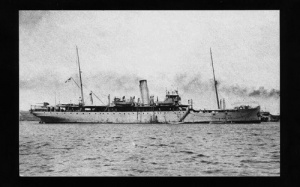HMAS Suva
| Class |
Steamer; Passenger Cargo Vessel |
|---|---|
| Builder |
Workman, Clark and Co Ltd |
| Commissioned |
23rd June 1919 |
| Decommissioned |
12th August 1919 |
| Fate |
Returned to owners |
| Dimensions & Displacement | |
| Length | 300 ft 3 inches |
| Performance | |
| Speed | 14 knots |
| Complement | |
| Crew | 146 |
| Propulsion | |
| Machinery | Triple expansion 3 cyclinder 414 HP. |
The steam ship Suva was built by Workman, Clark and Company of Belfast, Ireland in 1906 for the Australasian United Steam Navigation (AUSN) Company, and used on the Australia to Fiji passenger-cargo service and also the Queensland coastal passenger service from Brisbane to the Gulf of Carpentaria.
She was commissioned by the Royal Navy at Brisbane on 20 July 1915 as HMS Suva, and was converted to an armed boarding steamer at Garden Island, New South Wales. She was armed with two quick firing 4.7-inch guns, with a third gun later fitted in Colombo, Ceylon (now Sri Lanka). Suva departed Sydney with an Australian crew which was replaced with Royal Navy personnel when she arrived in Bombay, India. Suva initially operated in Indian waters before becoming part of the Royal Navy’s Red Sea patrol in December 1915, where her service included transporting and landing troops, shore bombardment of Turkish towns and inspection of Arab dhows for contraband. She also conducted a patrol of the Somaliland coast in 1916, and mine-sweeping off Ceylon during 1917. HMS Suva departed Aden in mid-April 1919 and returned to Sydney, via Colombo, in early June 1919.
Suva was commissioned into the Royal Australian Navy as HMAS Suva at Sydney on 23 June 1919 as a special service vessel, under the command of Captain Frank Hyde, RAN. She was equipped with two quick firing 3-pounder naval guns, and had a ship's company of 11 officers and 119 ratings. Her tasking was to transport Admiral of the Fleet Lord John Jellicoe to northern Australian ports, New Guinea and the Solomon Islands during his year-long Naval Mission to India and the Dominions (Australia, New Zealand and Canada), where he advised on the future naval defence for those countries.
Jellicoe arrived in Albany in the battlecruiser HMS New Zealand on 15 May 1919, and visited Adelaide, Melbourne and Hobart before the ship reached Sydney on 23 June. Some of Jellicoe’s travel was constrained by the ongoing Spanish Influenza pandemic, and the visit to Hobart was cursory at best. HMS New Zealand was considered unsuitable for the next stage of Jellicoe’s mission, which was the visit to remote ports and bays of the Solomon Islands, New Guinea and far north Queensland - hence the commissioning of Suva for this task. After his inspection of Sydney’s naval facilities, Jellicoe and some of his entourage continued northwards by train to Brisbane in early July. Others, including staff officers and 16 extra cooks and stewards from New Zealand, embarked in Suva.
HMAS Suva, wearing the flag of an Admiral of the Fleet, sailed from Farm Cove, Sydney on 3 July. Jellicoe embarked in Suva at Brisbane and the ship sailed on 5 July 1919. Suva steamed north to Cairns then across the Coral Sea to the Solomon Islands (visiting Florida Island, Guadalcanal and Tulagi), New Britain and New Guinea where Jellicoe inspected possible locations for future naval bases and fleet anchorages. At Rabaul he was met by HMAS Una, and a guard of honour from the garrison troops of the Australian Naval & Military Expeditionary Force was paraded in Jellicoe’s honour. On the return voyage Suva visited Samarai, Port Moresby, Thursday Island (26 July), Cairns (28 July) and Gladstone (1 August), before returning to Sydney on 5 August 1919. Jellicoe and some of his staff disembarked at Gladstone, traveled south by special train and rejoined New Zealand which departed Sydney soon after and sailed to New Zealand for the next part of the Naval Mission.
Due to Suva’s slow speed and a shortage of good quality coal on board, the planned visit to Darwin was cancelled. Jellicoe later complained of the poor level of discipline among the junior ratings serving in Suva. An investigation by Hyde into Jellicoe’s complaint found that ,rather than the men being hand-picked for this special activity, some commanding officers used the opportunity to divest themselves of lazy, ill-disciplined and inefficient men!
HMAS Suva was decommissioned on 12 August 1919 and returned to her owners later that year. She was sold on 15 July 1928 to Madrigal and Company of Manila and renamed Sirius. She was later resold in December 1929 to Cia Maritima (Fernandez Hermanos Incorporated Managing Agents) of Manila who renamed her Bohol. She was later reported as sunk during a Japanese air raid on Manila Bay on 16 April 1942.




